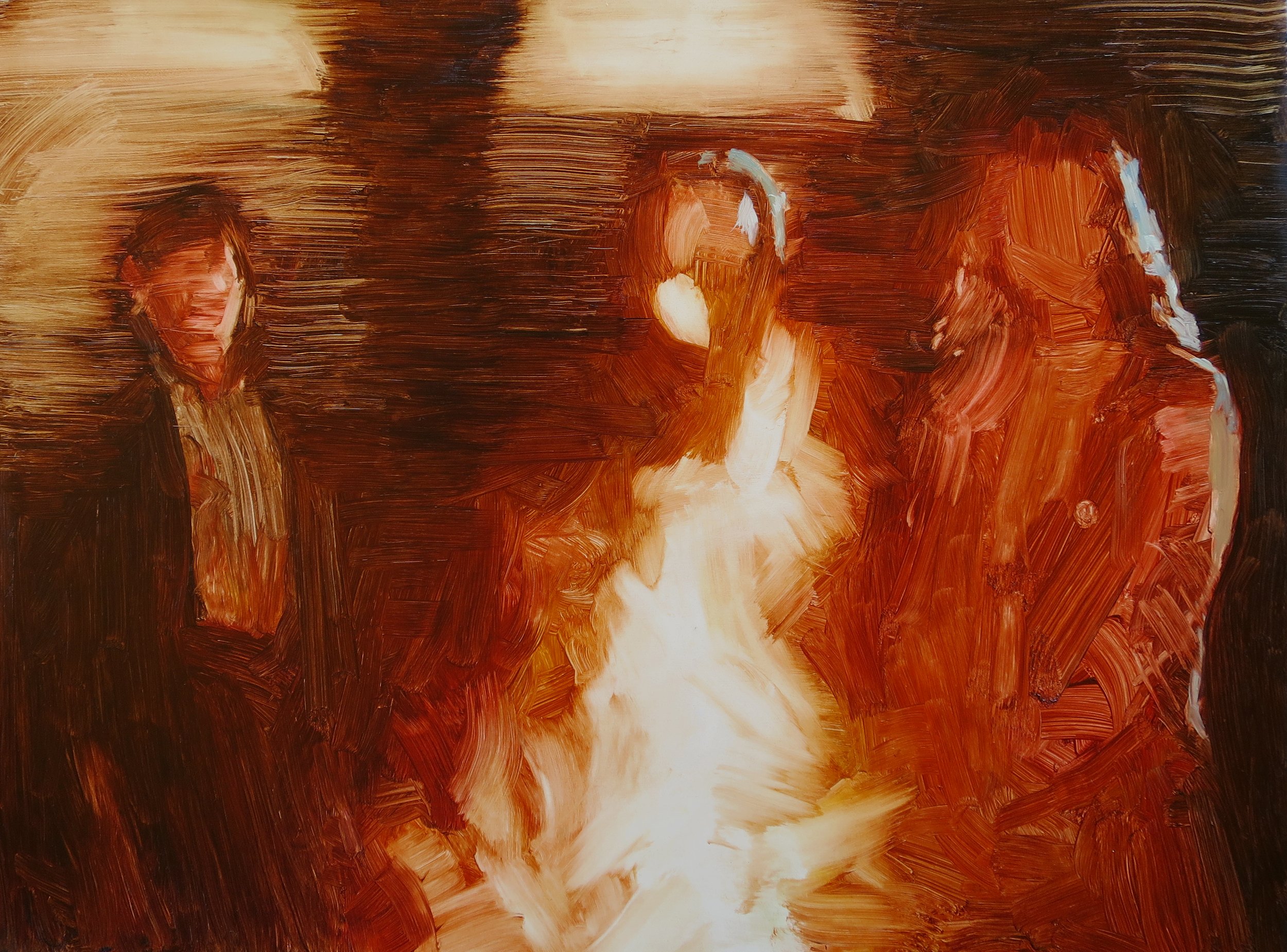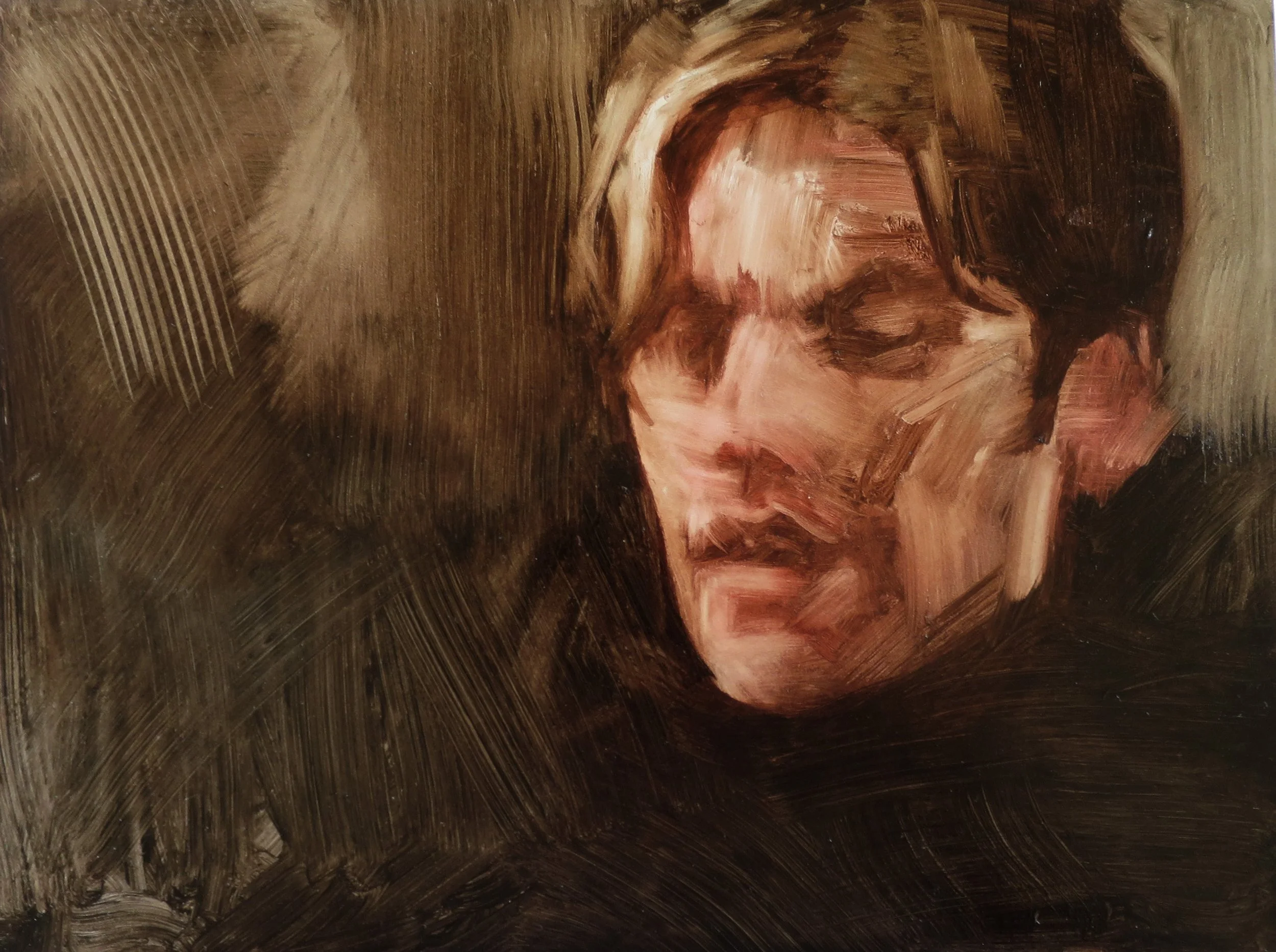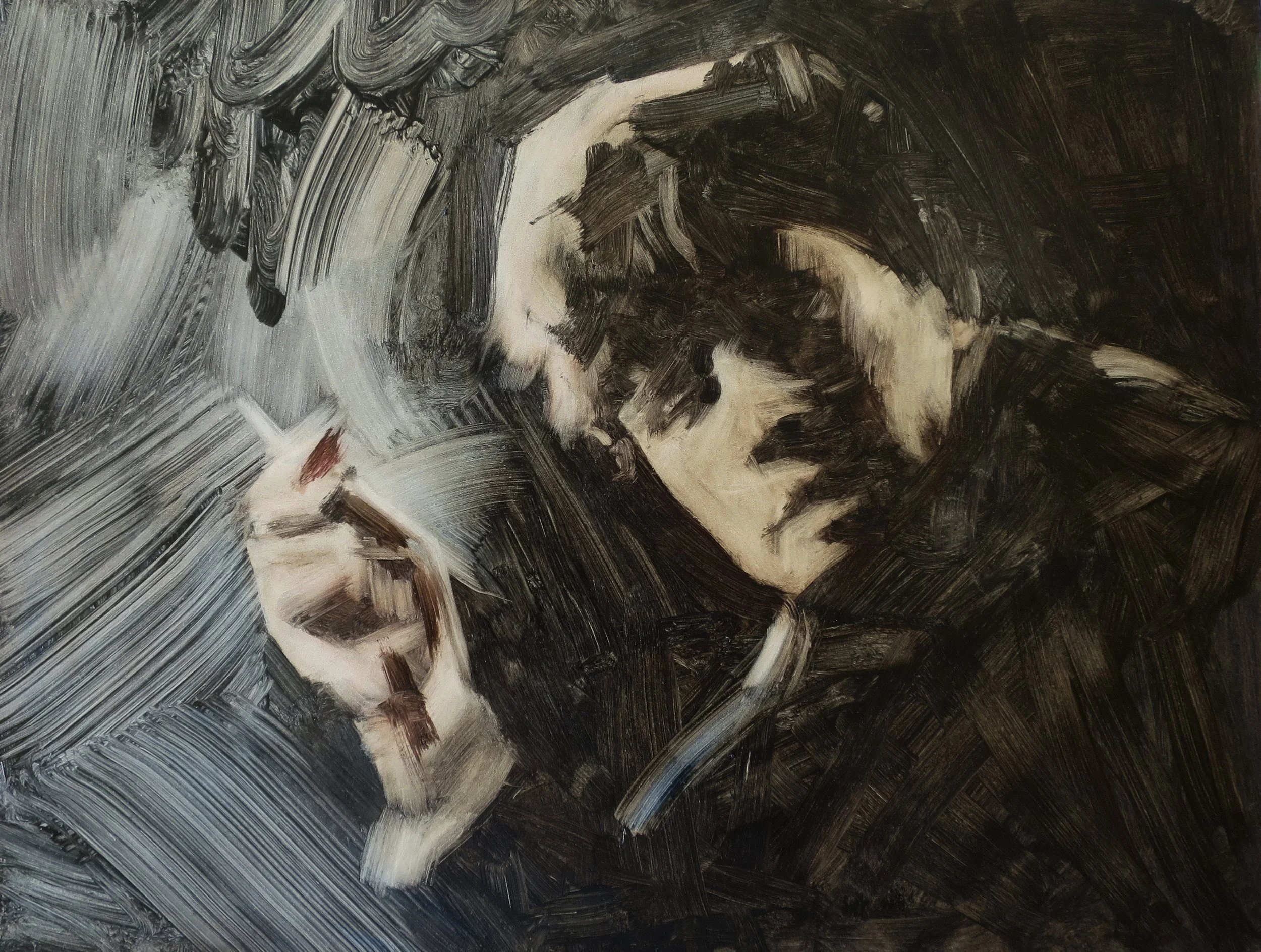Hot Trail
A solo exhibition of new paintings, on display at PoP Gallery in Meanjin Brisbane 7 - 18 March 2023
Install photos by Louis Lim
Hot Trail exhibition essay by Saskia Gilmour
There are not too many people who would laugh at a funeral, yet for some reason our human fascination with death has carved out a well-established place for British crime drama in Australia, with the genre regularly dominating Australia’s leading TV ratings. Perplexed by our fixation on British crime drama and its often highly predictable tropes, Miranda Hine’s solo exhibition, ‘Hot Trail’ captures our peculiar obsession with the genre and its ‘cosy’ portrayal of violent narrative content.
Across more than forty individual works, Hine has absorbed herself in the push-pull of paint to recreate cinematic scenes from a broad range of popular British crime drama series such as Midsomer Murders, Poirot, Vera, and Miss Marple. Welcomed into the common backdrop of a small, isolated English village, we are rushed through a barrage of both detailed close-ups and scenic shots – clocks by the night stand, the apparent burning of evidence, muddy slippers, assemblies of nameless faces, the village church, its vicar and a mysterious trail of footprints.
The exhibition is a continuation of Hine’s fascination with narrative construction, where she works through painting, installation and museum practice to continually interrogate, dismantle and reconfigure narratives and the structures that sustain them. Presented in a considered, ordered and almost archival manner, ‘Hot Trail’ can be seen as a documentation process, where an extensive dataset of episodes, scenes and plots form a foundation for observation and the extraction of trends and common themes. Through a confusing mess of red herrings and clues, Hine generates and sustains the ingredients required to piece together and construct a narrative. The gestures of characters and tonal quality of the works are drenched in the sense of suspense and anticipation that ‘hooks’ in viewers, despite displaying often predictable and repetitive scenes. Sketched together through a play of paint that stretches the physical and conceptual limits of the medium, Hine assembles each image through a brief play of brushstrokes that renders the key information of each scene apparent while obscuring further details.
The ambiguity of the works is intentional, creating gaps that both indulge in the richness of painting and leave room for the interpretation of the viewer. Even with a knowledge of the image sources and artist’s intent, gleamed in part from the formulaic artwork titles that read like archival tags, we scramble to make sense of the information provided. Working through our instinctual impulse to construct narratives from displays of objects and images, we are still unsure of the mystery at hand – is that Benedict Cumberbatch or is it the tyrannical town killer? Is that the murderer, detective or suspect? Or are we simply looking at a communal meeting, an awards night or a funeral? As common characters switch and reverse roles, the formulaic structure of British crime drama is laid bare; while we may for a moment feel ‘hot on the trail’ of revealing the answer, it also soon becomes apparent that the story we were searching for may in fact not be there at all.
As if a storyboard for a crime drama, at a glance we can absorb the solemn, sinister atmosphere of the paintings. The dramatically constructed scenes mirror the genre’s familiar cinematic style, where repetitive red herrings, religious iconography, emotive camera angles and extreme contrasts subtly work to reveal clues about the characters’ knowledge and power within the community. Exploring British crime drama with a playful curiosity, ‘Hot Trail’ highlights the almost concerning allure of the genre, where death is always around the corner, but the cheer and jolly disposition of the village is never disturbed. Through a dream-like painterly lens, Hine’s exhibition alerts us to the strangeness of this genre, causing us to question precisely what it is that attracts us to these seemingly distanced, British narratives, and why it is that we seek comfort in the hot trail of evidence and pursuit left by acts of violence.
Selected works
'Muddy shoes (red herring) (Poirot s5e7)', 2022, oil on board, 20 x 25cm (unframed)
'Not the murderer burning evidence (clown costume) (red herring) (Midsomer Murders s29e6)', 2023, oil on board, 61 x 91cm (unframed)
'Not the murderer burning evidence (photo) (red herring) (Death in Paradise s12e1)', 2023, oil on board, 13 x 18cm (unframed)
'Not the murderer burning evidence (newspaper) (red herring) (Queens of Mystery s1e6)', 2023, oil on board, 23 x 31cm (unframed)
'Not the murderer burning evidence (papers) (red herring) (Poirot s4e2)', 2023, oil on board, 20 x 25cm (unframed)
'DCI John Barnaby (from Midsomer Murders) as a suspect in Midsomer Murders (before he was DCI John Barnaby)', 2023, oil on board, 23 x 31cm (unframed)
'Endeavour Morse (from Endeavour) as the murderer in George Gently, 2023, oil on board, 23 x 31cm (unframed)
'Inspector Lewis (from Lewis) as a friend in George Gently', 2023, oil on board, 23 x 31cm (unframed)
'Reverend Sidney Chambers (from Grantchester) as a suspect in George Gently', 2023, oil on board, 23 x 31cm (unframed)
'A clock (red herring and murder weapon) (Jonathan Creek s2e6)', 2023, oil on board, 23 x 31cm (unframed)
'Frank Hathaway (from Shakespeare & Hathaway) as a suspect in George Gently', 2023, oil on board, 23 x 31cm (unframed)
'Father Brown (from Father Brown) as the murderer in George Gently', 2023, oil on board, 23 x 31cm (unframed)
'An overzealous vicar (red herring) (Shakespeare & Hathaway s3e2)', 2023, oil on board, 23 x 31cm (unframed)
'A watch (red herring) (Midsomer Murders s3e2)', 2023, oil on board, 15 x 23cm (unframed)
'The one with the priest hole (Father Brown)', 2023, oil on board, 13 x 18cm (unframed)
'The one with the priest hole (Vienna Blood)', 2023, oil on board, 13 x 18cm (unframed)
'Reveal gathering denouement (Poirot s13e1)', 2023, oil on board, 15 x 23cm (unframed)
'Reveal gathering denouement (Midsomer Murders s4e2)', 2023, oil on board, 15 x 23cm (unframed)
'Footprints in the flowerbed (red herring) (Poirot s5e7)', 2023, oil on board, 61 x 91cm (unframed)
'Reveal gathering denouement (A Touch of Frost s2e2)', 2023, oil on board, 15 x 23cm (unframed)
'Reveal gathering denouement (Jonathan Creek s2e5)', 2023, oil on board, 15 x 23cm (unframed)
'Reveal gathering denouement (The Madame Blanc Mysteries s1e5)', 2023, oil on board, 15 x 23cm (unframed)
'A clock (red herring) (Poirot s12e4)', 2023, oil on board, 61 x 91cm (unframed)
'An overzealous vicar (red herring) (Midsomer Murders s21e3)', 2023, oil on board, 46 x 61cm (unframed)








































